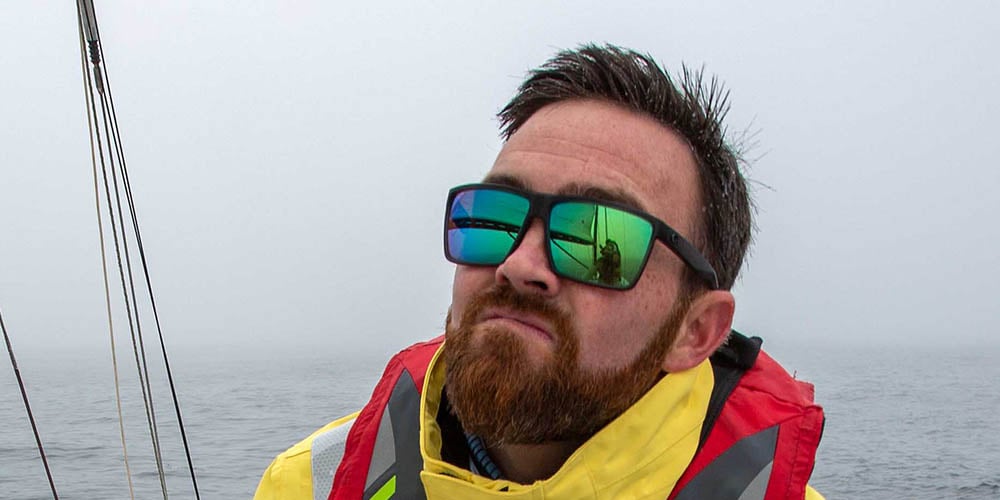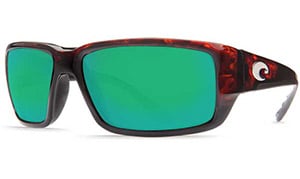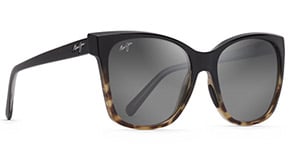
Protect Your Investment
Before we discuss choosing your new pair of sunglasses, it's important to know how to take care of them since proper care is the best way to extend the life of your sunglasses. Never use harsh cleaners or disinfectants on your sunglasses as they can damage the coating on the lenses and frames. To clean your sunglasses, rinse them with warm water and use a mild dish soap to wash the lenses if necessary. Dry the lenses using a clean, soft, absorbent cloth. Do not used paper-based products to clean your lenses as they can cause scratches and often contain added lotions or other products that will leave a film on the lenses.
Protection from Bright Light and UV Radiation
Sunglasses protect the eyes from the sun's damaging UV radiation, and improve visibility and comfort on the water by reducing light intensity and filtering out glare.
On the water, the combination of direct and reflected light is much brighter than on land. Unfiltered glare, the light reflected off flat surfaces like water, windshields, bright white decks and sails, is so intense that it impairs vision (a clear safety hazard). Glare causes squinting, fatigues the eyes, and can result in visual discomfort and headaches. Glare is present even on hazy days. Most sunglasses reduce light intensity by 80-90 percent with darkening gray, green, amber, or other colored lens.
Colored lenses alone are not enough protection for marine conditions. To filter out intense glare and prevent squinting, sunglasses for boating should be polarized. And they should be coated to block 99-100 percent of the damaging UVA and UVB (ultraviolet) rays that can reduce visual acuity at night, and cause degenerative eye diseases like photokeratitis, snow blindness, cataracts, pterygium, and various forms of eye cancer. Sunglasses should also be shatterproof to protect the eyes from injury in the event of sudden impact.
Polarized Lenses

Costa's Fantail Men’s Sunglasses feature polarized polycarbonate lenses that block 100% of UV rays, absorb harmful high-energy blue light (HEV) and filter out harsh yellow light.
When light rays reflect off a surface, the reflected rays concentrate in one plane and are said to be polarized. Reflected glare is an example of polarized light. Even on overcast days, the high–intensity light we call glare can be harsh and overwhelming to your eyes. It blinds you and masks what's behind it. Squinting blocks out some of the light, but not the glare. Ordinary sunglasses can reduce the total amount of light reaching your eyes but, like squinting, they don't eliminate the glare. A polarized lens filters out the glare by blocking all polarized light waves except those traveling in a specific orientation.
A polarized lens blocks horizontally polarized light with a polarizing film of molecules running in parallel vertical chains sandwiched between two optical lenses. These vertical chains block horizontal light waves, allowing only vertical light waves to pass through. Vertical light waves, commonly called "ambient light," are scattered evenly and don't produce glare. You can tell if a lens is polarized by rotating the glasses (or tilting your head when you are wearing them). You will find that they reduce glare better in some positions than others.
By blocking out only the polarized glare, the intensity of the light reaching your eyes is not reduced, so objects retain their definition and visual detail. This effect, combined with a tinted lens, makes it much easier to see and identify things both on and below the water like fish, buoys, skiers, wind zephyrs and underwater hazards.
Some manufacturers use polarized lenses to reduce glare on LCD instruments, fishfinders, etc. When viewed through sunglasses that are polarized differently than the instrument lens, no light is transmitted and the instrument face appears black. The only solution is to remove the glasses.
Visible Light Transmission and Lens Color
Lenses of different densities absorb different amounts of light. The amount of light passing through the lens is called visible light transmission, expressed as a percentage of total available light. For boating, visible light transmission should fall in the 15-30 percent range. On the brightest days, you want the lowest visible light transmission (darkest) lenses. Lenses are available in a bunch of different colors, and lens color is more than a fashion or attitude question. The technology behind the colors:
- Gray: a neutral all-purpose color that reduces glare, provides good contrast and no color distortion. Ideal for use on both water and land, especially for driving.
- Brown/amber: increases contrast in most light conditions. In addition to bright sun, amber offers excellent light management properties on cloudy or rainy days, and filters high-frequency near-UV light. Good for general purpose, high contrast light situations.
- Purple/rose: heightens visual acuity and enhances color (especially with objects against a blue or green background). Delivers brightest field of vision and is applicable for sight fishing, bass fishing, inshore fishing, sport shooting, extreme sports and skiing.
- Yellow: reduces the blue part of the spectrum. Blue light causes a scattering type of glare known as "blue haze." Best color for snow. Cuts through fog or haze, but has the worst distortion of colors.
- Green: offers enhanced visual acuity for specific light situations such as sight fishing, but is worn by many for everyday use.
Lens Shape
Optically speaking, the flatter the lens, the less distortion. Curved lenses refract, or bend, the light rays as they pass through, so light doesn't enter your eye in a straight line. Your eyes are forced to work overtime to process and correct the visual information, which may cause eye fatigue and headaches. This distortion can be eliminated with corrected prismatics; check the label for distortion-free prismatics before purchasing curved sunglasses. Lenses of good sunglasses are complex, and are constructed from several layers. The inside has an antireflective coating to reduce "bounce-back" on the inside of the lens and a water-repellant coating to shed water and make cleaning easy. An ultraviolet coating protects your eyes from UVA and UVB radiation.
Lens Material
Lenses made of polycarbonate are extremely tough, yet lighter than glass, and can be made oversized to wrap around the face and block entry of light, wind and dirt from the sides, top and bottom. Polycarbonate lenses are impact-resistant and shatterproof, an important safety feature, especially for sailors, who may be at risk of being struck in the face. They naturally block 100 percent of the sun’s harmful UV rays.
Trivex and Kaenon’s similar proprietary SR-91 have been available for about the past ten years, with UV-blocking and shatterproofness similar to polycarbonate, but they are stronger, clearer and lighter, with better chromatic distortion performance (less distortion as you look away from the center of the lens). SR-91 has better scratch resistance than polycarbonate.
Optically ground glass lenses provide the best quality and vision and are more scratch resistant, but they are also heavier. A "compromise" lens material is CR-39, a plastic polymer with optics superior to polycarbonate, but with similar impact resistance and the best scratch resistance of all plastic lenses.
Frames

Maui Jim's Alekona Women’s Sunglasses combine a stylish frame with their PolarizedPlus2® lenses which block 100% of UV light.
The best materials for boating sunglass frames are lightweight, flexible, durable materials such as nylon, propionate or acetate (also called zyl). Metal frames may be stylish, but they will quickly corrode to a ghastly green in a saltwater environment. Some manufacturers, such as Costa Del Mar, use corrosion-resistant monel in their frames.
Frame hardware is made with either strong, maintenance-free pressed-in pin hinges, or with spring hinges for a snug, comfortable fit. Frame hardware should be corrosion-proof. Most of the sunglasses we sell have corrosion-proof nickel-silver or stainless steel hardware.
Wire core sunglasses have heavy wire embedded in the temples and earpieces for maximum adjustability and shaping to achieve a custom fit.
Lenses can be waterproof coated to shed water and make cleaning easy, or mirror-coated to eliminate overhead and reflected glare at the front of the lens. According to one manufacturer, mirror coating provides more control over the transmission of specific wavelengths than lens color, so it can enhance the visual sharpness and contrast of the lens. Some lenses are also coated on the interior with an anti-reflective coating to reduce "bounce-back" on the inside of the lens.
Lens Styles
- Aviator style glasses are droplet shaped and follow the contours of the cheek.
- Cateye glasses are relatively round lenses with a single nose bridge.
- Clip-ons are for use with prescription glasses, and can be flipped up instead of removed for normal vision indoors or in low light conditions.
- Double bridge glasses connect the lens frames in two places–over the nose and between the eyebrows.
- Fisherman style glasses have small side lenses to block light from entering outside the normal range of vision.
- Shield style glasses have a large, single piece visor-like lens that shields the upper face, a style that's very popular for snow sports.
- Wrap-around sunglasses are highly curved both horizontally and vertically to match the contours of the face. By hugging the face closely on all edges, wraparounds do a great job of blocking light and wind from entering at any angle. Other styles blend features of these basic styles. More important than style is fit. See below.
Getting a Good Fit
Sunglasses should fit the wearer's face, not only to look good, but so the optical center of the lenses roughly matches the wearer's center of focus to minimize distortion. The three basic measurements for sunglasses are lens size, temple length, and overall width. Glasses should fit snugly without pinching. Weight can also be a factor in correct fit; glasses that are too heavy on the nose can cause headaches.